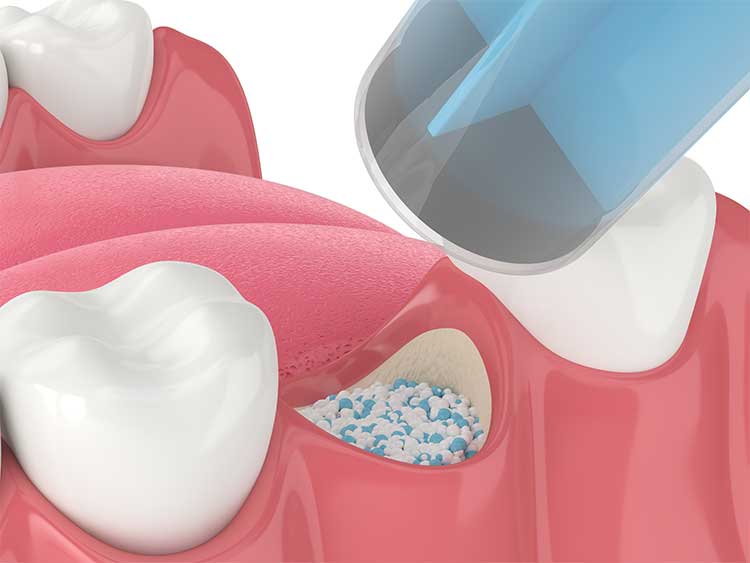What To Expect From Bone Grafting For Dental Implants
If you’re about to get dental implants, your implant specialist may tell you that you need a dental bone graft.
Dental bone grafting is a considerably small surgical procedure. In most cases, it only requires local anesthesia. The procedure reduces the potential for complications associated with weak jaw bone or bone loss associated with missing teeth. A successful bone graft allows the natural bone at that location to become stable enough to place a dental implant. Synthetic bone grafts can also be used to stabilize adjacent teeth.
If you’ve been told that you’re not a candidate for dental implants because of jaw bone loss, then a bone graft is an excellent option to consider.
What is a Bone Grafting Procedure?
This common dental implant surgery helps strengthen dental bone that is weak or too narrow/short in a specific area of your mouth. Since tooth loss and gum disease cause your jaw bone to resorb (shrink) it’s necessary to build the area back up before implants can be installed, or to prevent loose adjacent teeth.
A dental bone graft can come from a variety of sources. Bone graft material is natural and comes from an FDA-cleared donor source or is synthetic. Dental bone grafts can also come from the patient’s own body. For example, we can take the patient’s extracted tooth and turn it into an autologous graft as an alternative to a traditional bone grafting procedure using autogenous dentin grafting.
Typically, the bone grafting material is placed immediately after a tooth extraction, during a sinus lift (to prevent dropping of your sinus cavities), or just prior to installing your dental implants. It will require some time to integrate and strengthen your jaw bone before your implant dentist or oral surgeon can replace your missing tooth. As part of the healing process, your own bone becomes completely fused with the graft to create a stable foundation for dental work and tooth stability.


Are Bone Grafts Necessary for Dental Implant Placement?
If you’ve been told that you’re not a candidate for dental implants because of extensive bone loss, then a dental bone graft may be your solution to a better smile. Bone augmentation (grafting) is necessary when you have severe bone.
Not everyone requires bone grafting before they can get dental implants. A bone grafting procedure is usually only advised by your implant specialist if the bone is weak or too thin to install dental implants. Or in instances where your nasal sinus lining has dropped (because of tooth loss) and needs to be lifted. And even if you’re not getting dental implants, the bone grafting procedure can help stabilize other teeth in your mouth that have been compromised by gum disease.
How Long Does it Take for an Implant and Bone Graft to Heal?
A graft may take 3 to 6 months before the new bone is strong enough for implants to be installed. The surgical site needs to undergo a process called “osseointegration” where the grafted bone tissue stimulates the bone next to it, allowing them two to become fused together. Your implant is not installed until the bone is completely healed. The entire process is usually spaced out over the course of several months, from when the synthetic bone graft is installed to the final installation of your replacement tooth.
If you have questions about the recovery necessary for any dental surgery, keep in mind that it will vary from person to person. Your dental specialist will be the best person to provide you with a more accurate time estimate on a dental bone grafting procedure. Some minor irritation is common for a few days, with complete recovery usually complete within 6-8 weeks or so. To ensure things heal properly, you’ll probably want to stick to a softer diet and avoid chewing on that side of your mouth. You should not experience any type of severe pain, although minor bleeding or tissue irritation is common. If you recently received gum disease treatment, your implant dentist might even prescribe antibiotics to prevent infection in the soft tissue and blood vessels around your bone.
What is More Painful: Bone Graft or Implant Treatment?
Getting dental implants is relatively comfortable when it comes to dental care. Most patients only need local anesthetic to keep them comfortable, although some do prefer to be sedated during maxillofacial surgery. Prior to your dental implant surgery, our specialist will discuss what you can expect so that you can plan accordingly.
A bone graft may cause slightly more irritation than an implant, depending on where the bone grafting procedure is being performed in your mouth. If a sinus lift is being performed in your upper jaw, the area of your bone graft usually needs longer to heal than a dental implant does. But bone grafting placed immediately after an extraction or before a straightforward dental implant treatment may not cause anything more than some minor irritation in your gum tissue. Still, it’s probably best to stick to soft foods as your new bone integrates next to the neighboring teeth.
How Long Does a Dental Bone Graft Procedure Take?
Bone grafting treatments are usually fairly quick procedures. Especially compared to getting a dental implant. Normally a bone grafting procedure can be combined with other dental services, such as periodontal therapy or a dental extraction. Since the dental bone graft failure rate is extremely low, it’s a relatively straightforward way to help preserve natural teeth or establish a solid base for an incoming implant. The longest part of the dental bone grafting procedure is literally numbing the gums and accessing the graft location.
Who Should Perform a Dental Bone Graft?
In most cases, oral and maxillofacial surgery such as implant and bone graft placement are completed by a highly skilled implant specialist such as an oral surgeon or periodontist. At The Center for Advanced Periodontal and Implant Therapy our Los Angeles periodontists focus specifically on periodontal treatments and dental implant surgery. We offer associated dental care procedures such as bone grafting to stabilize teeth and implant restorations, among other more specialized periodontal services.
Learn more about if a dental bone graft is right for you and how they can improve your oral health. Contact our Los Angeles implant dentist today for a no-pressure consultation.
You May Also Like...
How Much Do Dental Implants Cost in Southern California? A Complete Guide
If you're considering dental implants in Southern California, you’re likely wondering: How much will they cost? Are...
Can Zygomatic and Pterygoid Implants Be Done in a Day? Breaking Down the Process
Losing bone in the upper jaw can feel overwhelming, especially if you've been told traditional implants aren’t an...
Are Dental Implants Noticeable?
If you've lost one or more teeth due to periodontal disease, trauma, or other dental issues, you might be considering...



